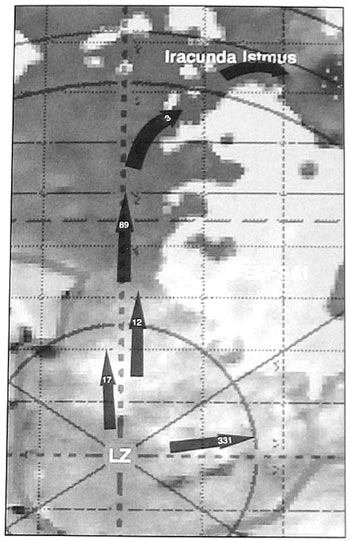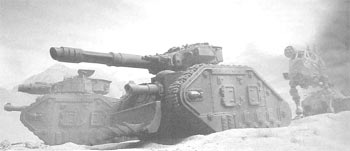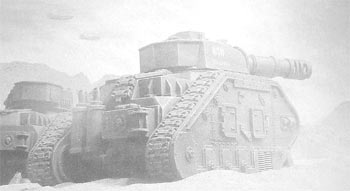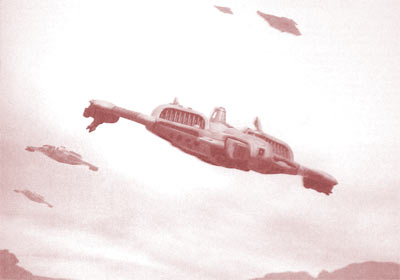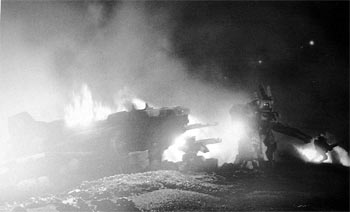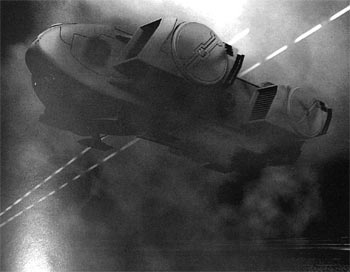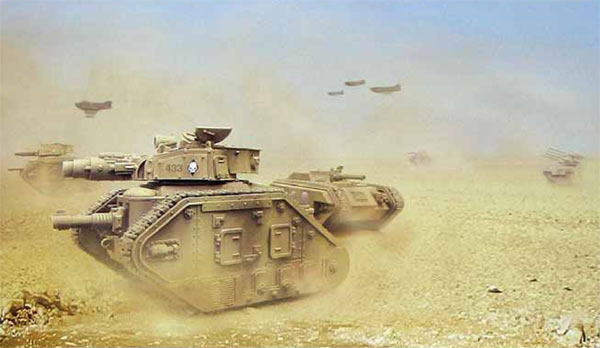 A pause in the advance, as a Tank company ot the 12th Tallarn Armoured regiment receives new reports from its forward scouts.
THE DESERT WAR
CHAPTER 5
Once the Imperial Guard forces had established a secure landing zone they did not move immedialely. Instead, they set up a strong defensive perimeter around the landing zone and began to reinforce and stockpile supplies. This process lasted two weeks. In the meantime the Tallarn regiments launched Sentinels and long-range infantry patrols into the desert to reconnoitre along expected routes of advance. The patrols encountered very little, the enemy continued to husband their strength and refused to committing to battle. Sightings of the enemy were zero. Where where the Tau? The second weeks build-up saw other Imperial Guard regiments and more Departmento Munitorum units land. Airbases were rapidly constructed by the labour corps, simple strips of flatten earth, before Imperial Navy aircraft deploy from their carriers in orbit. The 23rd Elysian Drop Troop regiment arrived and started the long process of transferring their three thousand men and one hundred and eighty aircraft to the surface. Only once everything was in order, X Corp was in place, and the supply stockpiles were large enough would Lord Marshal De Stael move from his defensive posture to an offensive one. The agreed objective of the ground offensive was to capture Tarokeen and the star port, secondary objectives were to find and kill the Planetary Governor, and destroy all the Tau forces on Taros. The city of Tarokeen was situated on the Iracunda Isthmus, a strip of land between Taros' two major seas Its location gave De Slael's planners a problem. The city was only approachable by ground forces from the west or east. The eastern end of ihe Iracunda Isthmus was very narrow (less than 15 kms) and represented a dangerous bottleneck tor the Imperial Guard. Tau forces could easily block this route of advance and force a stalemate. With no room to manoeuvre, only costly direct assaults would breakthrough to the City beyond, and De Stael did not believe he had the men required for such brutal, atlritional warfare. He decided to concentrate his efforts on the western end of ihe isthmus, which was wider and should allow the Imperial Guard's numbers and firepower to tell. Before the offensive could begin there was a High Command staff meeting onboard the Righteous Power. Lord Commander Gustavus arrived in person. He was concerned that not threatening the eastern end of the Isthmus would allow the defenders to mass their forces at the western end and make any breakthrough far harder to achieve. Gustavus believed a diversion was required to draw any enemy forces away from the isthmus and pin them down, if not by action, then at least by the threat of imminent action. After a long discussion it was agreed that a second attack was needed, and De Stael adjusted his plans accordingly. For this new task the Lord Marsha, requested Captain Orelius attend his next planning council. Orelius' Raptors would be required again, this time to launch a powerful armoured strike from the landing zone eastwards, circling around the south of the southern sea. The Space Marines' objective would be to draw Таu forces to them, and defenders to the eastern end of the Iracunda Isthmus. The Space Marines need not speak to engage the enemy in a decisive battle, but the threat of the Space Marines presence, if only for a while, would help the main northwards advance by drawing away resistance. Captain Orelius and his fellow officers strongly disgraced. His battle brothers were not being usefully employed if they were to act as a mere diversion force! Unhappy with the plan for his forces, Captain Orelius declined the mission, but did offer to include his forces alongside the main advance, even to form the spearhead of the first armoured thrust, rather than be "underemployed in a sideshow to the main campaign", as he called it. Irritated by Captain Orelius' refusal to sanction De Stael's plan but unwilling to risk the complete loss of his valuable Space Marines allies, Gustavus insisted De Stael revise his offensive plan. Instead of the Space Marines making the diversionary eastward thrust, it would fall to the raw 331st Tallarn regiment, their first action since being founded. As unblooded troops the 331st were best given an easier introduction to war against a cunning alien foe than thrown into the crucible on the front line. The objective would remain the same as for the Space Marines, but the advance, being mostly on fool, would be somewhat slower. Still, the whole of the regiment's men and tanks marching through the desert should draw Таи forces to them and out of the path of the main advance. Colonel Usfal Hamid, the commanding officer of the 331st, was summoned and given his orders by De Stael. Advance eastwards for thirty days then establish a new defensive blocking position anchored against the south coast of the Em-sai. The 331st regiment's advance would begin on the same day as the main offensive and should be pushed forward with vigour and aggression, the diversion has to look like the real thing.
With the issue of the diversionary spearhead resolved, De Stael turned to planning his main northward offensive. It would advance on a wide front, driving north across the desert and then swinging east onto the Iracunda Isthmus. Rather than concentrate all his combat power, De Stael elected to spread it out. This would seem to go against the teachings of the Tactica Imperialis, but so far all De Stael's intelligence reports suggested the Таu forces would not be numerous enough to stop him everywhere. If one sector of the advance was halted by Таu action, then another would be advancing unimpeded. Overall, the offensive would keep moving forwards. A broad advance with the Tallarn regiments side-by-side would make for steady gains. De Stael's offensive timetable called for the Tallarn regiments to make an ambitious twenty kms a day, but he expected that in some sectors along the front the Таu would stand and fight, and that sector would naturally be slowed down or halted by combat. If the Таu committed their forces to battle in one sector, then others sectors would be able to move faster De Stael's staff believes an average of twenty kms a day should operating in a familiar environment. At this rate, it would take sixty days of advancing to reach the outskirts of Tarokeen. With his offensive timetable complete De Stael turned to his supply officers. He ordered that sixty days of supplies would be required. Enough ammunition, food and, most importantly, water must be stockpiled. Reports showed that available stockpiles were currently at approximately half this, enough for thirty days, but supplies continued to flow from orbit unimpeded. De Stael decided that thirty days оf supplies was enough to begin his offensive, the rest would follow as the offensive progressed. It was a fateful moment. De Stael's offensive strategy would see X Corp of 4621st Army take the lead role. It would involve the Tallarn Infantry regiments advancing, using their own Armoured companies and artillery to support the lead Infantry platoons. The 12th Tallarn regiment would be on the right flank and the 3rd Armoured regiment would be kept behind the front line as the corp reserves, for deployment only if the offensive started to stall. Arrayed from west to east the X Corp formation would be: 17th Tallarn regiment on the left, 89th Tallarn regiment in the centre, 12th Armoured regiment on the right. Behind would follow the 3rd Armoured regiment. Striking eastwards would be the 331st Tallarn regiment. The other Imperial Guard regiments of XI Corp, once they had been landed, would be held as the strategic reserve. Should this offensive fail to reach Tarokeen then De Stael would turn to these units and a new plan. The difficult attack on the eastern end of the Iracunda isthmus would be spearheaded by the Raptor's Space Marines with the Warhound Titans of Legio Ignatum (when they arrived) and the Tallarn tanks in support. The weight of his attack should carry the offensive through the bottleneck and on to the outskirts of Tarokeen itself. Once in position around the city, De Stael would besiege the enemy, cutting off water supplies before the final assault with the fresh regiments from XI Corp. The detailed planning of the assault on Tarokeen would have to wait until the offensive got well under way. For the thousands of men from Tallarn it would be a long, hard march in hot, harsh conditions, but they would have tank support, and their artillery would constantly move up to keep the front lines in range. The Imperial Navy would be flying combat air patrols and bombing raids from their newly established airbases. The Tau might slow them down and even gain local successes, but the offensive would press on, grinding ever forwards by its weight of numbers.
At 514998.M41 De Stael ordered his regimental commanders to begin the long drive towards Tarokeen. The offensive began with a sustained rolling artillery bombardment all along the front line. Mortars, battle cannons, Earthshaker cannons and Griffons began an intense barrage. It was as if the gods themselves were hurling thunderbolts across Taros. The noise, concussion and great belches of fire from each muzzle made a huge din. Thunderous explosions rolled across the desert, followed by geysers of sand and flame, one here, another there, the blasts coming so thick and fast that they merged into a single roar. Pillows of smoke and flame shot skywards in a wall of high-explosive which crept, metre by metre, across the desert. The rolling barrage crept forwards for thirty minutes before the infantry began their advance. Every gun in the corp was blazing away. It was a barrage designed to soften up any enemy forces lying immediately ahead of the first advance. As the infantry rose from their dug-in positions they could feel the ground shaking and hear the out-going artillery shells whine and scream overhead. If the enemy was out there, they were taking a pounding, and that gave the Guardsmen great heart. Then, as suddenly as it had started, the barrage ended. A strange calm descended after the storm. Ahead of them, the infantry could see a thick pall of dust rising, into which the first platoons advanced. Strung out in line abreast the lead Infantry squads began to move forwards at a steady rate. Along side or just behind them followed the tanks. Leman Russ' grinding the desert sand into dust, engines revving and belching black fumes into the air. Each platoon beqan to finds its own way forwards. The screen of reconnaissance troops in front still reported no enemy contact. The front line reached the barrage area it was a landscape scarred by still smoking shell craters. The sand had been scorched black, boulders had been shattered into pebbles, but their was no evidence that the opening, bombardment had hit anything other that the empty desert. The advance moved deeper into the desert a steady march that continued all day, and still no sign of any resistance. Some started to think perhaps the Tau had given up Taros, and the campaign would be a walk over. By nightfall on the first day the forward units had covered the required twenty kilometres. As darkness fell the artillery pieces hooked up to their Trojan tows and began to move forwards into new firing positions. Already the advance had outstripped the guns ranges, even the long Earthshaker cannons were at the extreme edge of their range. It was a night-long task to drive or drag the weapons forwards, dig new firing positions and prepare for tomorrow with fresh ammunition supplies from the stockpiles. The night was as bitterly cold as the day was stifflingly hot. Ice had formed on many of the Imperial Guardsmen weapons during the short hours of darkness, it soon melted with the dawn sun. Day two was to be a repeat of day one, but without the pre-planned rolling barrage. Such a high ammunition expenditure could not be maintained everyday. Instead the guns would target those locations the Tau might be occupying for brief harassing firemissions, before standing by to assist any units that came under attack.
As the artillery and mortars opened fire again, the infantry began their advance. Morale was high, so far there had been no resistance. By mid-morning all that had changed. The Tau had been waiting for the advance since the landings on Taros. Their Pathfinder squads and Stealthsuit units had already scored a significant success before a shot was fired, by observing the locations of Imperial Guard units and alerting the Hunter Cadre commander as to the likely routes of advance for the lmperial Guard's armour. The Hunter Cadre commanders, following Shas'o R'myrs' instructions, were well hidden in the desert and waiting to move forward and counter the advance. The Hunter Cadres were formidably equipped for mobile desert warfare with its wide open battlefields and engagements which commonly took place at long ranges, most notably with railguns and Seeker missiles. Twenty four hours before the offensive was set in motion, crack Stealthsuit teams, operating in darkness and evading Imperial Guard patrols, had noted the build-up of equipment and stores, and forecast that the Imperium's forces were readying for an attack. The Tau had left no formations within artillery range, but their mechanized Hunter Cadres were well supplied with Devilfish transports, they could move forwards and react quickly and decisively when the time came. It was finally judged that the time had come on the second day of the Imperial offensive. The Imperial Guard infantry and tanks had left their perimeter defences of sand bags, razorwire and minefields behind, and were now in the open. Attacks should be swift, keeping the enemy at a distance. They needed to inflict casualties then withdraw back into the desert. Hopefully the Imperial Guard would pursue. The next day they would be hit again. Tau forces engaged in brief long-range firefights all along the front on that second day. The 17th Tallarn regiment suffered the strongest counter-attack at midday. Approaching an abandoned mining facility, called Tungusta Station, the Tau struck in force with Hammerheads and Seeker missiles. At first light on the second day, the Tallarn 17th regiment resumed its advance along its entire front. On the command of their officers the men rose from their quickly dug foxholes whilst tanks gunned their engines and began to grind slowly forwards. Behind them the artillery opened fire from new firing positions, hitting selected targets all along the front. The regiment's three Armoured companies formed the cutting edge of the advance, with squadrons of Leman Russ tanks stretched out across the desert sands. Lacking Chimeras the advance would be at walking pace. It would be another day of slow, steady gains. As the combined force of Armoured companies and Tallarn infantry moved across the desert they encountered their first enemy. A Hunter Cadre had moved forwards into engagement range. These forces had sped to intercept the Imperium's tank spearheads, guided by Pathfinder teams which were already observing the Imperial Guard's advance from a distance. The faster moving Tau grav-tanks had arrived in the vicinity of Tungusta Station only minutes before the Imperial advance. Tungusta Station was a small collection of buildings, lean-tos and old mining equipment, abandoned by its operators after the Imperial forces arrived. It had already been scouted and then shelled by the artillery as part of the preparation for the days advance. The surrounding area was pockmarked with Basilisk shell craters. The battle started as the lead tank encountered a hidden Tau Pathfinder unit. The Leman Russ opened fire with its battle cannon. Using their Markerlights and Seeker missiles, the Tau's return fire immediately knocked out the Leman Russ, which started to burn fiercely as the crew tumbled out of the hatches to the desert floor. Their position compromised, the Pathfinders quickly withdrew on foot. In the distance, on the edge of the Tungusta Station, Hammerhead gunships appeared and opened fire with their railguns. The whip-crack sound of railguns soon filled the air. The surviving Leman Russ' souight cover, firing off smoke launchers and returning fire, Vanquisher and battle cannon matched against railguns in a deadly long-range duel. With the armoured vehicles pre-occupied in their own private battle the Imperial Guard infantry, led from the front by their commanding officer, Lieutenant Kavir, pressed forward towards the buildings. The men of 1st platoon, 2nd company, advanced towards the outskirts of Tungusta Station only to encounter Fire Warriors supported by Devilfish troop carriers. A fierce fire-fight ensued. Lieutenant Kavir was killed during the attack as his command section was overrun and annihilated by counter-attacking Crisis battlesuits, probably the Cadre's Shas'el commander in person. Without close armoured support the Tallarn platoon was heavily outgunned. They urgently called for reinforcements, and a Storm Trooper squad was ordered forwards to their location. A Thunderbolt fighter was also scrambled to intercept the Tau forces.
The arrival of more Tau reinforcements and a low flying Barracuda strafing the battlefield decisively swung the fight in the Tau's favour. Out-matched, 1st platoon fell back with heavy losses, despite the timely arrival of the Storm Trooper reinforcements, speeding to the fight in their Chimeras. The Thunderbolt air support raced low overhead to bomb Tungusta Station. Already three Leman Russes were burning in the desert. In this sector the advance had stalled for the day. As the Imperial Guardsmen withdrew from Tungusta Station, destructive artillery fire was directed onto the buildings. For several hours Basilisk shells again pounded the entire area. In darkness, a patrol was ordered to investigate the ruins of Tungusta Station. They found little remaining. The enemy had already withdrawn to regroup, leaving only the smouldering wrecks of a single Hammerhead and a Devilfish troop carrier behind. Next morning, the advance resumed, with 2nd companys 5th platoon being ordered into the front line to replace the battle-weary survivors of 1st platoon. Later that morning, 5th platoon's cautious advance captured the remains of Tungusta Station without further resistance from Tau forces. Tungusta Station was just the first of many such attacks throughout the following days, designed to weaken the front line units and temporarily stall them. Sudden sharp attacks all along X Corp's front line became a daily hazard. On the right flank, the 12th Armoured regiment was expenencing similar problems. The Hammerheads and Broadsides, with their railguns and mobility, excelled in these conditions. Unbroken fields of fire allowed them to target the Leman Russ firsts, before manoeuvring to avoid return fire. Once the tanks were destroyed, the Chimeras carrying infantry support were powerless to respond. Crews had to rely upon the weight of the Leman Russ armour for survival, but against the fearsome railguns it was not always enough The ominous whip-crack of railguns became a sound each Imperial Guardsman learned to hate and fear. The Tau's weaponry seemed to slice through armour at any range The magnetically-driven, hyper-sonic passage of each round heated the air so it seemed to fizz and crackle. The speed was such that infantry men stood too close would find the air sucked from their lungs as it passed overhead. The slipstream of each round would raise the sand, forming a speeding, swirling trail of dust which cut across the desert faster than the eye could track. With little cover to hide from the railguns, the desert war was costly in equipment. After five days advancing, the 12th Armoured regiment had lost 50% of its tank strength amongst the forward deployed companies. They had inflicted some damage on the enemy, but it was an uneven exchange. Replacement tanks could be found, but not enough to make good all the losses. The regimental commander, Colonel Ahsa-Bilad, recognising that his Tank companies needed the extra support, deployed the Basilisks of his first Artillery regiment forward, to act as assault guns rather than conventional artillery. His artillery was proving ineffective against very mobile targets It was a shrewd move, by utilising their Earthshaker cannons longer range, the artillery helped level the playing field But the regiment was already falling behind its twenty kilometres a day timetable, and Basilisks, like Leman Russes, were vulnerable.
in those first days of the desert war, a typical tank engagement might run something like this. The lead Infantry platoons would be advancing. In line abreast, directly supported by a Leman Russ. Lying in wart for them would be a single small Pathfinder team, well h.dden amongst rocks. Thev would target the Leman Russ with their Markerlights, and far to the rear a volley of Seeker missiles would be launched, locking onto the target tank. The first the lmperial Guard would know about the attack would be the sudden destruction of the tank under multiple missile impacts. Other tanks would move to reinforce, only to come under long ranqe fire from railguns as Hammerheads skimmed forwards into range. A long range exchange of fire would take place between the armoured vehicles, whilst the Imperial Guard infantry pressed forwards. The infantry would be counter-attacked by Fire Warrior units racing forwards in Devilfish transports, dismounting and again engaging at long range with pulse rifles. The Imperial Guardsmen were outgunned in the infantry firefight, although their squad snipers did achieve some kills with their longer ranged weapons. As the Guardsmen pressed forwards, casualties mounting, they might be able to bring their heavy weapon squads, mortar batteries or, if a forward observer was present, their heavy artillery to bear. As Tallarn fire built the Tau would board their transport vehicles and withdraw rapidly, to be followed by their Hammerheads. The battlefield would be left in the Imperial Guards possession, but at a cost in tanks and men. Lord Marshal De Stael's staff began to analyse and understand the tactics the Tau had adopted and looked to counter them. First of all, the Pathfinder teams need to be hunted down more vigorously. Reconniassance squads were reinforced with more Sentinel units to aid them in this new mission. Neutralise the Tau scouts and the long range ambushes would be harder to achieve. This had some success, with scouts units regularly clashing in small skirmishes. The light Sentinels still proved to be vulnerable to the Tau's weaponry and many were lost during these engagements, but each clash of scout patrols meant the front line behind would be free from the Seeker missile ambushes. The losses in Sentinels was compensated for by the saving in tanks and men behind them. Next, De Stael looked to his own mobility to counter Tau speed. As a response force he turned to the Imperial Navy The Thunderbolts and Lightnings of the Imperial Navy fighter wings would be the solution. If the tanks could not bring the Tau decisively to battle, then the aircraft could. Air patrols over the front line would be increased, with pilots given license to roam, locate and engage targets of opportunity Squadrons were put on standby to scramble should a front line unit report contact with the enemy. These would race to the front line and deliver devastating volleys of Hellstrike missiles. The Tau might outrun his artillery, but they could not outrun the Imperial Navy.
As De Stael's operational tactics evolved, naturally so must have the Tau's. For the commanders, the war was a to-ing and fro-ing of move and counter-move, plan and counter-plan. The Imperial Navy was heavily active for several days over the front line, the sky criss-crosed with vapour trails and filled with the roar of jet engines. The Thunderbolts of the Imperial Navy began to find ground targets, scoring notable success and inflicting heavier losses on the Tau than the ground forces had managed. The Tau's response was to commit its own air forces in increasing numbers. Barracudas began to be seen over the battlefield, not in a ground attack role, but diving from high altitude to intercepting the Imperium's aircraft. From distance bases on the Iracunda Isthmus the Barracudas kept up patrols to defend their ground forces. The air war over Taros had begun. Dogfights became common between the two evenly matched forces. This drew the Imperial Navy's resources away from its ground attack role, and once again the Hunter Cadres were freed up for their probing counter-attacks. Despite the losses and the escalation of the ground war into the skies, the offensive continued to grind forwards through the desert. After ten days it had made up to one hundred and fifty kms; it was behind schedule by between 30 and 50 kms but the broad front was still moving northwards daily. The established pattern of the campaign continued as the Imperial Guard moved northwards, but within the first weeks the pace of the advance started to slacken After twenty days they had covered approximately three hundred kms. All regiments were reporting problems with their supply lines. Convoys were not making it to the front line, days past whilst there was not enough fuel for all the vehicles. Only when it arrived could the regiment push on and attempt to make up for lost time. Water rationing was having to be strictly enforced by Commissars. This made offensive operations increasingly difficult and slow. On the left flank of the broad front, the Tallarn 17th was approaching an upland area known as the Phyyra Heights. These rugged escarpments scarred the distant horizon with their steep slopes. Orders from De Stael's headquarters were for the regiment to swing slightly westwards and capture the high ground, hopefully outflanking the majority of the Tau defenders and opening a clearer path to the Iracunda Isthmus. For the past seven days the 17th Tallarn regiment's advance towards the Phyyra Heights had gone without incident. The Tau had left the regiment to its slow flank march, and twenty five days since the offensive began the lead platoons found themselves at the foot of a steep, rocky climb into the highlands. The regiment's reconnaissance squads had arrived several days before the main body, moving on foot up the slopes at night. The scouts had begun to seek the best routes through the rocky terrain. Several prospective routes had been identified, and the first probe by Sentinel units had not been attacked. The versatile walkers faired well on the steep hillsides, but it was terrain the regiment's supporting tanks would find highly restricting. Since arriving, the Recon squads had spotted a few enemy tracks, but in the process several men had been injured by rockfalls (at the time, these were put down to unfortunate accidents). Amongst the lower slopes they had no confirmed sightings of the enemy, and had not found any indication of an enemy force present in large enough strength to threaten the continued advance. Meanwhile, unknown to those below, the Tau's savage allies, the Kroot. were hiding and waiting on the high ground. A few Kroot trackers ventured out to keep an eye the humans and set rockslide booby traps, but the main forces kept to the high ground, never exposing themselves to the human scouts. If they were spotted, then it would bring the heavy artillery down on their heads. The Master Shaper was clever enough to know that in the dense rocky terrain his ferocious kindreds and hounds would be at an advantage. Once spotted, his forces would become the targets of heavy shelling, and this might force him to withdraw. Out of the hills, in the open desert, his forces would stand little chance against the enemy's firepower. If the Tallarn advance was to be stopped, it would have to be here. General Barim-Abas issued his orders to capture the high ground. In scorching heat, the lead companies and platoons set off on the arduous climb. Scout squads and Sentinels showing them the way. From their caves and rocky hiding places the Kroot emerged, hungry and ready to fight. They scurried downhill to hide behind the first ridgeiine. On each Shaper's command the warbands rose as one. suddenly appearing on the ridgeiine above the guardsmen as a long howling line. With hounds baying and Knarlocs shrieking the Kroot charged headlong downhill. Leaping from rock to rock their momentum carried them into the Imperial Guardsmen below. Suddenly it was desperate fight. Some Tallarn units fled rather than face the bloodthirsty savages. Other squads sought cover, stood, fought and died on the Kroot's blades or savaged by wild alien beasts. With his vanguard platoons under sudden and heavy enemy counter-attacks, General Barim-Abas ordered all his artillery to open fire on the first ridgeline. Directed by forward observers team on the hillside, mortars and Earthshaker cannons launched repeated barrages up the hillside. Fire and dust engulfed the ridge. The heavy fire gave the lead platoons enough time to withdraw, and mercifully the Kroot did not follow, preferring to remain amongst the dense cover on the high ground. Bloodied and weary the Tallarn Guardsmen had been repulsed, but the fighting to Climb the Phyyra Heights was just beginning. Over the next ten days, three more attempts tо storm the treacherous slopes each ended with the regiment being thrown back with heavy losses. A fourth attack led personally by General Barim-Abas, did capture the first ridgeline. The 17th regiment's offensive had stalled. The only reserve force available to aid them was the Tallarn 3rd Armoured regiment, but their Leman Russes and Chimeras could not operate effectively in the highlands. De Stael wisely refused to commit them. He would seek a breakthrough elsewhere whilst the 17th skirmished with the Kroot for possession of a barren rocky wilderness of little use to either side. For the 17th, it was the high water mark of their advance on Tarokeen. They had captured three hundred and fifty kilometres of desert. With the 17th Tallarn regiment now involved in a protracted battle against Kroot warbands to capture the Phyyra Heights, Lord Marshal De Stael turned to his other three regiments to carry his stalling offensive to the mouth of the Iracunda Isthmus. He ordered his reserve regiment, the 3rd Tallarn Armoured, to reinforce the 89th and 12th Armoured regiments, adding fresh firepower to the front line. The 3rd regiment, under Colonel Hasso Ras-Aziz, was divided into three battlegroups, titled А, В and C. Battlegroup A moved to reinforce 12th Armoured, В moved to reinforce 89th regiment and С remained as the reserve. The new tanks added new impetuous to the offensive, and for a while the pace began to increase again.
At 596998.M41 Battlegroup A, 3rd Armoured, spearheaded a fresh attack. Amidst the heavy diesel stink and creaking tracks of armoured vehicles, the combined weight of the regiment's first and second Tank companies struck northwards with renewed vigour. A cloud of dust hung over the desert as the tanks passed by. followed close behind by Chimera carriers and Basilisks. As ever, the Tau were wailing, picking off tanks with railguns before falling back again. The attrition continued, the first day alone cost the 3rd regiment six vehicles. On the third day, the lead elements of Battlegroup A came into sight of a the large mining operation at Gaidamak, where the land was scarred by deep quarries in the earth, surround by towering spoil heaps. Surveying the area through his magnoculars, General Ras-Aziz made plans to attack and capture the mine. Giadamak was a huge strip mine where the ground had been torn up over centuries, its deep quarries leaving dramatic rends in the earth and huge, strangely regular mounds of waste rock piled high. If was a desolate and dusty place, home to several thousand miners until the approaching lank columns forced most to flee to safety. Some hardly work-gangs vowed to stay and fight. The scattered quarries, buildings, workings and equipment hid the defenders. The deserts provided little cover for the attackers. Where once the clanking and grinding of heavy machinery had rumbled across the desert, all was now silent. Fire Warriors scanned the southern horizon for the tell tale dust columns of the approaching tanks. Lord Marshal De Stael suggested that General Ras-Aziz ignore the tricky mining complex and move around it, striking for the bigger prize of the Iracunda Isthmus, and leaving the defenders isolated. The General disagreed. He could not allow a strong Tau force to remain behind his front line. His lead units might reach the Iracunda Isthmus, but the Giadamak defenders could then launch a potentially catastrophic counter-attack from their strong point rollinq through the regiment's vulnerable rear areas. In his opinion the mine must be seized and the defenders killed, captured or forced to withdraw. An attack would clear the way for the continued advance northwards. The veteran Tallarn General made this clear during a briefing onboard De Stael's Leviathon. The Lord Marshal concurred with his front line commander. The attack would begin at first light next day. The briefing complete General Ras-Aziz climbed aboard an Aquila shuttle and flew back to his forward command post to oversee the battle. As the first rays of light crept over the dark horizon, the rumble of heavy artillery fire once again rolled out across the desert. In the dawn light. Earthshaker and mortar explosions blossomed all around Giadamak. The men gathered ammunition, ration supplies and filled canteens before climbing aboard their vehicles and slowly moving to the start lines. The regiment's attack plan was simple. Two Tank companies would envelope the mines, circling to the west and east. When the tank vanguards had met, the mine would be surrounded and cut oft from reinforcements. Then the infantry would move in. racing forwards in Chimeras behind a rolling barrage of artillery fire, before dismounting and closing the last few hundred yards on loot. It would be the dismounted infantry that would roust the Tau from their hidden positions in close quarters fighting, under the covering fire of their transports. The attack started well, with the tanks moving out to the left and right unmolested by Tau fire. With the crack of artillery still resounding the Leman Russ columns bounded forwards in two wide arcs. In the centre, the Chimeras advanced in line abreast behind a wall of Earthshaker fire. With two hundred yards left, the artillery screen lifted and men dismounted to dash forwards and seize the objective. As the infantry closed in the Tau opened fire, flaying the dismounted Tallarns with pulse rifle fire. The Tau had created a killing zone in front of their position with interlocking fields of fire. The leading Tallarn infantry were now caught in it, and men started to fall one after the other. As they attempted to advance, the men of Tallarn were dusty tan shapes running, falling, crawling, firing, rising again and fall again, wounded and writhing The heavy pulse fire was punishing. Soon the flat ground was littered with the small hummocks of dead and wounded men. Second company, the first to attack, was repulsed with heavy loses. They retreated in disarray leaving a hundred dead behind. His first assault defeated, General Ras-Aziz ordered a fresh Armoured Fist company forwards. This time it would be third company's turn. Again muzzle flashes erupted from the defenders' lines, scouring the desert with pulse rounds. Chimeras moved forwards to lend their tire, multi-lasers whining, heavy boilers chattering return fire. Leading the attack was Captain Hadid. His own Chimera was hit thirty five limes by pulse rounds, eventually penetrating the front armour and killing his driver. Dismounting, the captain rallied his men and led the way, closing in on the objective. The weight of Chimera tire and the platoon's supporting mortars was having an effect, suppressing the defenders as the first Tallarn platoons reached the edge of Giadamak. Now the fighting would become close and personal. With knives and grenades in hand, squads were stalking through the billowing smoke and rusting machinery, hunting down the entrenched defenders. Meanwhile, the encircling tanks had completed their envelopment against only light resistance. They took up positions to repel any attempted Tau breakthrough to help the force now surrounded amongst the deep quarries of Giadamak. There was little the tank commanders could do as, in mid-afternoon, the Tau launched an aerial evacuation. From the east a formation of four Orcas, surrounded by a defensive shield of Barracudas, raced overhead, banked steeply towards the mine and came in to land. The Tau were withdrawing again. Fighting amongst the quarries was more like street fighting than desert warfare. The artillery could no longer fall as the forces were too close and intermingled. For three hours the battle was a brawl fought with grenades, knives and sometimes bare fists. The Tau had little stomach for such combat. The Hunter Cadre commander had called for an evacuation. He had inflicted his damage here, it was now time to cut-and-run before his force was annihilated. The Orcas swooped in. burst cannons raking the sand and the Fire Warrior teams withdrew under the covering fire of their sacrificial rearguard. Scurrying away they loaded up and quickly took to the air. From his command post. General Ras-Aziz watched through magnoculars as one by one the Orcas lifted off and banked away northwards, chased by sporadic Hydra flak fire, whilst Barracudas circled above. The survivors of Giadamak moved to mop up the Tau rearguard, quickly rounding up the haggard, wounded and battle-weary alien prisoners. In all, sixty three prisoners were taken. The 3rd Tallarn regiment's losses stood at 322 killed or wounded and eleven vehicles destroyed. That evening, sixty-eight Tau bodies were piled into a single mass grave and bulldozed over. After a day of heavy fighting Giadamak was now a fire scoured wilderness, dotted with artillery impact craters, littered with spent powercells, bloody bandages, smouldering wreckage and the dead of both sides. After another fourteen days of advancing, faced by daily Tau sniping, the front line, led by Battlegroup A, had closed to within fifty kilometres of the objective. But they too were now running out of tanks, fuel and water. As the front line pushed forwards the lengthening supply lines felt the pressure. The second phase of Shas'o R'myr's campaign plan was starting to reap its rewards. With so many units committed to the rear echelon raids, the Tau commander might no longer have enough Hunter Cadres to stop the offensive, but the Imperial Guard was slowly running out of momentum due to its own logistical needs. Whilst the 17th regiment fought for the Phyyra Heights and De Stael committed the 3rd Armoured to give his offensive new momentum, the Tau had started to infiltrate deep into enemy territory. The second phase of their campaign plan had begun. Operating mainly at night, Tau Fire Warrior, Pathfinder and Stealth teams dropped via Orca into the desert and fanned out in search of targets. Night after night, Orcas flew secret transport missions to drop more teams, seeding the Imperial Guards' rear area with raiding parties, under orders to identify supply routes and dumps, headquarters and airfields. Once located, then action would be planned. Teams were only sanctioned to conduct ambushes on supply routes. Other Pathfinder teams were dropped with Tetra speeders, allowing them to move with great speed to each new target. Pathfinder and Stealth teams operated in unison to attack Imperial Guard supply columns of Trojans towing trailers full of water, fuel and ammunition. Rear area security was mainly being conducted by Sentinel and Rough Rider squadrons, and these proved ineffective against the small, well-armed Tau teams. Day after day, convoy after convoy was ambushed. The Pathfinders inflicting rapid loses before withdrawing back into the desert. Soon, supply routes were marked by the blackened hulks of destroyed Trojans and trailers, or the slowly bleaching bones of horses killed in ambushes. Security was increased. Armoured Fist squads were withdrawn from frontline duly to help defend the vulnerable convoys, but the Tau attacks continued. One large supply dump was destroyed in a night-time raid without a shot being fired. Pathfinder teams infiltrated past the dump sentries to stealthily set charges amongst the fuel cans and ammunition crates. Just before dawn a huge orange fireball rose out of the desert, waking even Lord Marshal De Stael onboard his Leviathon command vehicle. At dawn there was a tall mushroom cloud of dust and smoke marking the supply dumps location, still rising high info the sky for all to see for miles around. By 640998.M41 the offensive towards Tarokeen had ground to a halt, lacking replacements and supplies. The 12th Armoured, spearheaded by Battlegroup A of 3rd Armoured, had almost reached the mouth of the Iracunda Isthmus; the other two infantry regiments on their left hadn't made it so far. The 17th regiment was stuck in the Phyyra Heights, and although they had made some small gains, no breakthrough seemed imminent. The 89th regiment thinly filled the gap between the two flanks. Far to the south, the 331st regiment had advanced to the southern shores of the Em-sai and was now digging in, but the Tau had not fallen for the feint. Up until now the air war over Taros had continued daily, an evenly matched duel, with both sides struggling to gain superiority. The Tau had the edge in numbers, but the Imperium had the edge in experience. It was a battle neither side could afford to lose. Unless the Tau dominated the skies, their defensive strategy would be facing a major problem. If their Barracudas could no longer protect the Hunter Cadres then the Imperial forces would have an advantage in the ground war. The Hunter Cadres would be exposed to repeated air attacks, and forced to rely on their Sky Rays for defence, which were proving themselves a potent weapon against ground targets when used in conjunction with small Pathfinder teams. Also, Barracudas and Tiger Sharks were playing a big part in the second phase of the campaign, strafing supply convoys. The Imperial Navy was still putting up an alarming fight, and at this time it was the main threat to Shas'o R'myr's campaign plan. Urgent action was needed to help swing the balance of the air war in their favour. The Tau launched a daring raid to destroy Imperial Navy aircraft whilst still on the ground. Small Stealthsuit teams had already infiltrated the Imperial Guard rear area. Operating only at night, their mission was to find and report the location of Imperial supply dumps and convoy routes. They were under strict orders not to engage the enemy, just to find potential targets for other strike forces to attack. They received new instructions: their mission was now to find the airbases. These were now the highest priority targets. 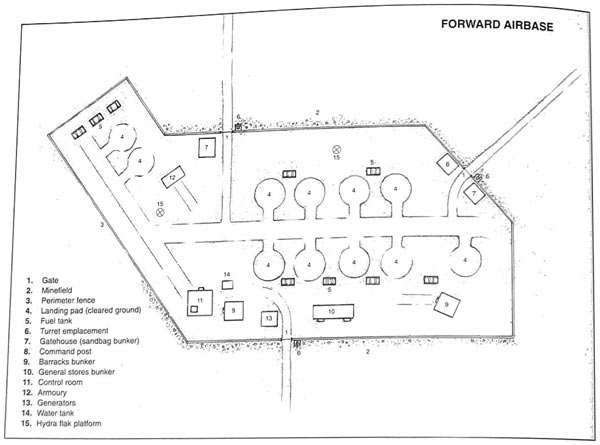
When a patrolling Stealth team reported the location of the forward airbase. Shas'el K'irri responded quickly. Utilising only his best Fire Warrior teams he gathered an elite strike force. His plan was simple but very dangerous. In a daring night-time raid, a single Orca loaded with troops would fly low over the desert and pass directly over the airstrip. The Fire Warrior teams and their support units would jump out, and under the covering fire of drones and Crisis battlesuits, destroy all the grounded aircraft with EMP grenades. Shas'el K'irri would lead the attack himself. After the drop the Orca would circle round and return to land directly on the airfield. Once the enemy aircraft were destroyed and the Orca had landed, the teams would fall back to the Orca and make a rapid escape, covered by a flight of Barracudas scrambled to intercept any Imperial pursuit. Surprise would be on their side but once the airbase realised it was under attack they would respond quickly and in force. K'irri warned all his chosen Shas'la that the chances of survival were low. They would be deep in enemy territory and should anythinq no wrong, they would be cut-off. But should they succeed then it could have dramatic effects on the front line. It was a risk worth taking for the Greater Good!
To start with the attack went as planned. The Orca, equipped with blacksun filters and a disruption pod to make it difficult to track, approached the airfield, skimming fast and lower over the desert surface. On its final approach to the target the Orca attracted the attention of the airbase's anti-aircraft defences and sustained several hits as the Hydra flak guns opened fire. Once over the airfield, the rear ramp lowered and the troops jumped out, hitting the ground and immediately going into action. As tracers from the Hydra's autocannons lit up the night sky, the Fire Warrior teams raced towards the parked aircraft. The Shas'el's Crisis battlesuits leapt towards the Hydra platforms, silencing them with multiple hits from plasma rifles and missile pods. illuminated by the fires of the burning Hydra, an emplaced multi-laser guarding the perimeter fence found its ranqe, destroying a battlesuit. which exploded in a shower of sparks. Pinned in their command post by fire from Gun Drones the guard command section called for urgent help Other security squads were already rushing to their aid. First to arrive was a squadron of Sentinels, attached to the airbase for rear area security duty. The confused night-fight escalated, pulse rounds and lasgun blasts criss-crossing the airfield, until, with sudden bright explosions, one after another aircraft began to explode. In all, six explosions in quick succession lit the darkness, fountaining flames and sparks from the cockpits of the grounded Thunderbolts. The destruction of the aircraft did not see the end of the fighting. The Orca had circled the base and returned to land on the runway. Such a large target attracted a lot of fire from the defenders. The dropship attempted to return fire with its own burst cannons, only to be rocked by repeated impacts. One engine started to burn, crippling the aircraft and preventing it from taking off, gradually the flames engulfed the Orca, forcing the crew to abandon ship. The mission had achieved its objective, but for the attacking Tau teams, there was no longer any escape. Deep in enemy territory they fought on throughout the night until overwhelmed by the defenders. Every raider was either killed, wounded or captured in the attack, including Shas'el K'irri.
As dawn broke it revealed the results of the intense fighting. Six aircraft lay as smouldering wrecks, along with the Hydra turrets, battlesuits and the gutted Orca, flames still flickering from inside the stricken dropship. The airbase was shrouded in acrid smoke and littered with the dead and wounded of both sides. It was a scene of devastation. The cost had been heavy on both sides. The Imperial Navy had suffered the loss of its aircraft and the airbase was out of action until the debris could be cleared. The Tau had lost their entire raiding force in the strike. What the overall effect on the campaign would be, it was too early to tell. The attack on the airbase was not the end of the raids. More supply dumps would be located and then targeted by Pathfinders. Convoys continued to be ambushed by stealth teams or strafed by Barracudas. It was a plan designed to cripple the frontline regiments by reducing their supplies to a trickle, and it was working.
|
